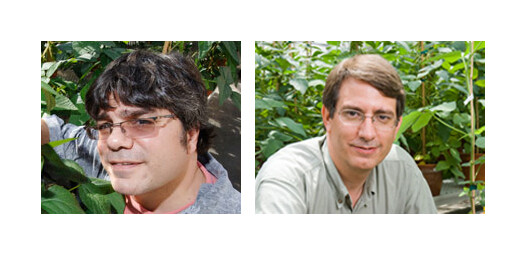
UNL plant scientists Ed Cahoon and Tom Clemente aim to super-charge plants for biofuel production.
Their research is part of two multi-institutional research collaborations supported by an Advanced Research Project Agency-Energy program of the U.S. Department of Energy called Plants Engineered to Replace Oil. PETRO supports innovative research to develop cost-effective, sustainable sources of transportation fuel from non-food crops.
DOE requires ARPA-E PETRO recipients to demonstrate progress to continue receiving funding. The two UNL Center for Plant Science Innovation researchers recently cleared that hurdle.
Biofuels offer sustainable alternatives to petroleum-based fuels that could reduce greenhouse gas emissions and improve the nation’s energy independence. First, however, researchers must improve biofuel crops’ oil production and other characteristics to enhance their efficiency.
Camelina, a non-food oilseed crop in the mustard family, is productive in the Great Plains and other dry climates, said Ed Cahoon, George Holmes University Professor of Biochemistry and director of the Center for Plant Science Innovation. To improve camelina’s value as a biodiesel and jet fuel source, he’s using biotechnology techniques to reduce its polyunsaturated fatty acid content, so the oil is less oxidatively reactive and has a longer storage life.
Cahoon is part of the Center for Enhanced Camelina Oil, a consortium of universities and institutes led by the Donald Danforth Plant Science Center in St. Louis.
“Individual groups have made accomplishments in different areas, and now we’re at a point where we’re trying to assemble all the traits into one elite camelina germplasm,” he said.
Sugar-rich sorghum is used to make ethanol, but it has the potential for use in biodiesel production as well. Tom Clemente, Eugene W. Price Distinguished Professor of Biochemistry and director of UNL’s Plant Transformation Core Research Facility, is using his expertise in plant transformation to genetically modify sorghum to be a substrate in oil production, as well as to increase yields and widen the U.S. growing range.
The research has benefits that go beyond biofuels, Clemente said. “We’re trying to enhance photosynthetic capacity in general, and, if true, that could be translated into other commodity plants as well.” Examples include increasing the nutritional value of soybeans or wheat.
He’s working with a team of universities and institutes led by the University of Illinois at Urbana-Champaign.
Both projects have been extended for an additional 18 months, after which ARPA-E projects are expected to entice private investment. UNL’s portion of the funding for the two ARPA-E PETRO projects is $1.3 million.
“That’s really the hope,” Cahoon said, “that we’ll bring something far enough along that industry will get interested in it and take it from there.”







